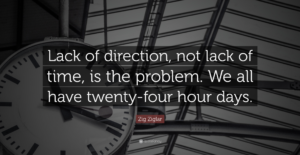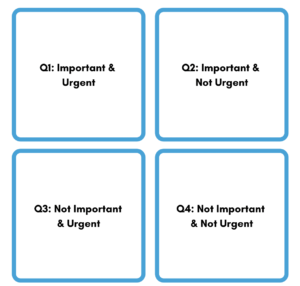How time management leads to retention.
Best Practice #2 Time Management
We can’t expect our team to do this, if we haven’t mastered this ourselves.
Choose to invest your time, not just spend it.

Many people complain about a lack of time being the biggest problem, when a lack of direction is the real issue.
Schedules are not jail cells, they are meant to help us do two things.
#1. Live the life we’ve always dreamed of living.
#2 Steward our time well.
In order to do this well, we must know our personal mission. Once we can identify our personal mission, we can then know what priorities we must have. Then we schedule our priorities.
The Eisenhower Matrix for time and task management is a great tool to use, to see where our time is going.

The goal is to spend 80-85% of our time in Quadrant 2: Important & not yet urgent.
Activities/Priorities which fall under Q2 include:
- Planning
- Family time
- Reading
- Reflecting
- Disciplines
- Personal Development
- Tasks that are coming up but don’t have an immediate dead-line
- Maintenance on the house or car
- Fun activities, vacation, birthday parties, retreats
- Etc.,
The goal is to spend 5% or less of our time in Quadrant 1: Important & urgent.
Activities which fall under Quadrant 1 are:
- Forgotten task or things
- Procrastinated projects or deadlines
- Car trouble
- Unexpected doctor visit
- Procrastination due to poor planning/execution ahead of time
The goal is to spend 5-10 % or less of our time in Quadrant 3: Not Important & urgent.
Activities which fall under Q3 include:
- Unexpected calls or emails
- Requests from peers
- The inability to manage distractions
- Unclear Priorities
- Excessive Distractions due to a poor environment
The goal is to spend only 5% or less of our time in Q4: Not important & not urgent
Activities which fall under this Quadrant are:
- Binge watching TV
- Mindlessly scrolling through our phone
- Anything that would not be in line with your priorities in life and lead to distraction and a loss of focus
Take an hour either at the beginning or end of each week to think through your upcoming priorities.
Schedule in your priorities.
Plan in white space for life bombs — those unexpected things that come up that we just can’t plan for.
If your schedule is too full and you do not have an hour of time each week to spend on planning.
Don’t lose hope.
We suggest to start with a minimum of 5 minutes everyday looking over your schedule and what must get done and execute accordingly.
Spend 15 minutes every week to reflect on what happened, what could have been done better, and then prepare for the next week.
Happy scheduling and stay posted for part 3! ✨
– Coach Carissa
